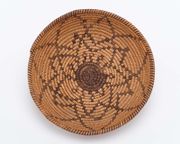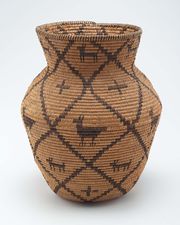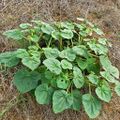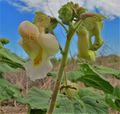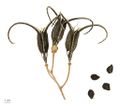Difference between revisions of "Devil's claw"
Jump to navigation
Jump to search
(Created page with "thumb|'''MFA Acc. #:''' 49.414 == Description == 1) An uncommon annual plant (''Proboscidea altheaefolia'', ''Proboscidea parviflora'') that is nat...") |
|||
| (11 intermediate revisions by the same user not shown) | |||
| Line 1: | Line 1: | ||
| − | [[File: | + | [[File:Coiled tray MFA.jpg|thumb|Native American tray<br>MFA# 1993.723]] |
| + | [[File:Coiled jar MFA.jpg|thumb|Native American jar<br>MFA# 1993.728]] | ||
== Description == | == Description == | ||
| − | + | An uncommon annual plant (''Proboscidea altheaefolia'', ''Proboscidea parviflora'') that is native to arid area in southwestern United States. Devil's claw was named for its large seed pods with hooked ends. The pods are edible before they ripen and become woody. The mature pods turn black or brown and split open releaseing the seeds. Fibers from these pods were used for weaving baskets. | |
| − | + | Another plant, found in South Africa ''Harpagophytum procumbens'' is also called "devil's claw". | |
| − | |||
| − | |||
| − | |||
| − | |||
== Synonyms and Related Terms == | == Synonyms and Related Terms == | ||
| − | ''Proboscidea altheaefolia''; ''Proboscidea parviflora''; | + | ''Proboscidea altheaefolia''; ''Proboscidea parviflora''; black martynia; devil's horn; unicorn plant |
| − | + | == Additional Images == | |
| − | |||
| − | == | ||
| − | |||
| − | |||
| − | |||
| − | |||
| − | |||
| − | |||
| − | |||
| − | |||
| − | |||
| − | |||
| − | |||
| − | |||
| − | |||
| − | |||
| − | |||
| − | |||
| − | |||
| − | |||
| − | |||
| − | |||
| − | |||
| − | |||
| − | |||
| − | |||
| − | |||
| − | |||
| − | |||
| − | |||
| − | |||
| − | |||
| − | |||
<gallery> | <gallery> | ||
| − | File: | + | File:Devils claw plant Vorderbruggen.jpg|Devil's claw plant; image credit Burr Williams |
| − | File: | + | File:Devils claw flower Vorderbruggen.jpg|Devil's claw flower; image credit Burr Williams |
| + | File:Devils claw flicker.jpg|Devil's claw seed; image credit Terri Cox | ||
| + | File:Proboscidea_parviflora_MHNT.BOT.2011.18.23.jpg|Proboscidea parviflora - Capsule and seeds - [[https://www.museum.toulouse.fr/fr/web/guest/accueil MHNT]] | ||
</gallery> | </gallery> | ||
| Line 56: | Line 22: | ||
* Foraging Texas [[https://www.foragingtexas.com/2012/07/devils-claw.html website]] | * Foraging Texas [[https://www.foragingtexas.com/2012/07/devils-claw.html website]] | ||
| − | + | * Wikipedia: https://en.wikipedia.org/wiki/Proboscidea_(plant) (Accessed Oct 2020) | |
[[Category:Materials database]] | [[Category:Materials database]] | ||
Latest revision as of 12:17, 12 October 2020
Description
An uncommon annual plant (Proboscidea altheaefolia, Proboscidea parviflora) that is native to arid area in southwestern United States. Devil's claw was named for its large seed pods with hooked ends. The pods are edible before they ripen and become woody. The mature pods turn black or brown and split open releaseing the seeds. Fibers from these pods were used for weaving baskets.
Another plant, found in South Africa Harpagophytum procumbens is also called "devil's claw".
Synonyms and Related Terms
Proboscidea altheaefolia; Proboscidea parviflora; black martynia; devil's horn; unicorn plant
Additional Images
Proboscidea parviflora - Capsule and seeds - [MHNT]
Resource and Citations
- Foraging Texas [website]
- Wikipedia: https://en.wikipedia.org/wiki/Proboscidea_(plant) (Accessed Oct 2020)
